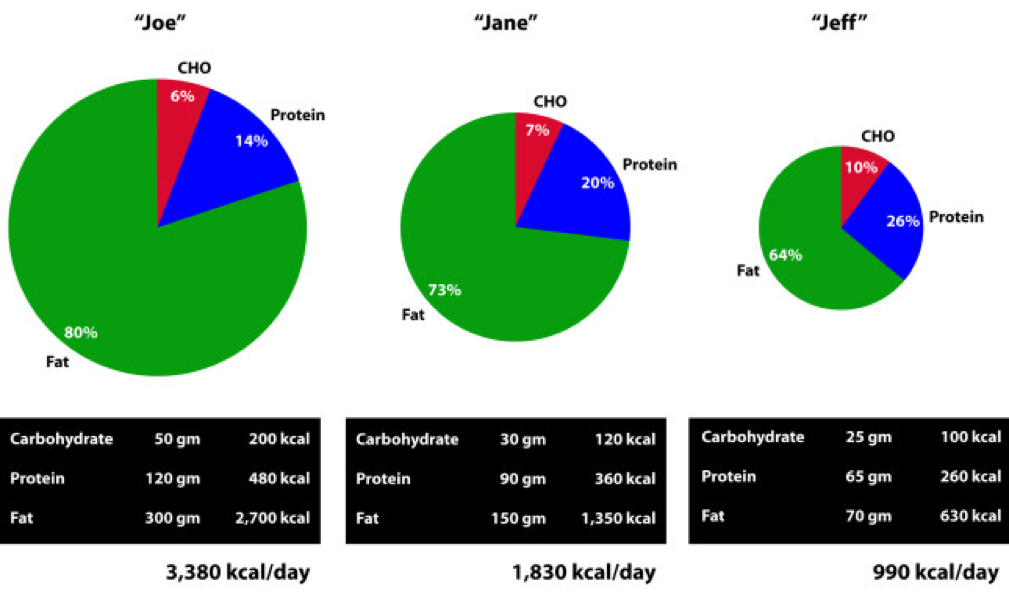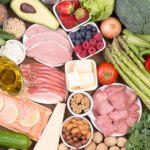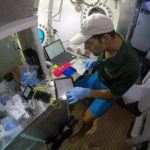For reasons I’m still struggling to understand, the idea of “nutritional ketosis” (NK, to be distinguished from starvation ketosis, SK or diabetic ketoacidosis, DKA) is often discussed and debated in much the same way as religion or politics. Perhaps this can be said of all nutrition, which is a shame. Nevertheless, in my continued defiance of such sensitive topics, I’d like to add another layer of complexity and nuance to this discussion.
The “rule of thumb” for NK is that caloric intake is determined as follows (this excludes a subset of ketogenic diets known as calorie-restricted KD which, as the name suggests, is specifically restricted in calories):
- Carbohydrate (total, not “net”): less than 50 gm/day, but ideally closer to 30 gm/day
- Protein: up to 1 to 1.5 gm/kg, but ideally below about 120 gm/day
- Fat: to satiety
Let me illustrate what this looks like for Joe (left), Jane (middle), and Jeff (right — an example of a calorie restricted KD), three hypothetical people in NK — but each with different caloric requirements.
As a general rule, as caloric requirement increases the proportion of calories derived from carbohydrate and protein decreases (and the contribution of dietary fat increases), even while absolute intake of carbohydrate and protein increases.
Anyone who has bought a blood ketone meter knows how tough it can be to get “into” ketosis by carbohydrate restriction (since everyone asks, I use the Abbott Precision Xtra meter which uses two different strips: one for glucose and one for beta-hydroxybutyrate, or BHB). Most practitioners consider the minimum threshold of NK to be a fasting serum level of BHB above 0.5 mM. I’m a bit more stringent in my practice and like to see fasting BHB levels above 1 mM. To give you a sense of one person’s numbers (mine), over a 6-month stretch in 2013, when I was in NK, my mean (i.e., arithmetic average) morning fasting level was 1.7 mM with a median value of 1.4 mM. The highest morning level during that period was 5.2 mM. (The highest morning level I have ever measured in myself is 5.7 mM.)
But, it took me a long time to get it right, especially since at the outset of my foray into NK I was consuming between 4,000 and 4,400 kcal per day. (My average daily caloric intake for weight stability was about 3,800 kcal per day, which was validated by doubly-labeled water.) I could still easily “fall out” of NK. For example, on my daughter’s 5th birthday she insisted I have some of her tikka masala (contains lots of sugar), naan bread, and mango ice cream. How could I say no to a birthday girl who insisted on going to the nicest Indian restaurant in San Diego? As to be expected, the next day my BHB was 0.2 mM, and it took me 2 days to get back above 1 mM.
Here’s a little secret I’m about to let everyone in on… I like carbohydrates. I love sushi (though I now mostly eat sashimi). I love Indian and Thai food, though I prefer to make curry myself to keep sugar out. I make (and eat) the best hummus this side of the Nile River. I’ve figured out how and when I can eat them to meet the following conditions:
- Stay in NK (except on a few occasions like my daughter’s birthday);
- Increase my anaerobic performance;
- Preserve most (but not all*) of the benefits I enjoyed when I was much more strict about my ketogenic diet.
How, you ask? By learning to calculate my glycogen deficit.
(*) For me, the leanest body composition I achieved as an adult was in strict NK with no attempts to do what I’m about to describe below. Since I’m not a model and nobody cares if my body fat is 7% or 10%, I’m happy to be a little less lean if it gives me the flexibility to increase performance and live a slightly more sane life. At least for now.
PLEASE NOTE: I have never suggested, and can’t imagine I ever will suggest, that a KD is “best” or “right” for everyone. What I describe below may seem extreme, both in the amount of work required and the actual application. I fully acknowledge that (1) this is a highly analytical approach to eating, and (2) that I’m a “freak” (my wife’s words, not mine). I certainly don’t do this often, unless a lot is on the line (e.g., a big ride), but I like having this technique in my armamentarium.
If you’ve watched my presentation from 2013 at the IHMC, then you’re familiar with RQ. Through years of metabolic testing I have a pretty good sense of my RQ at any moment in time – when I’m sleeping, when I’m sitting around (most of the time), when I’m riding my bike at 200 watts, when I’m riding my bike at 400 watts, when I’m lifting weights, etc. This allows me to calculate what proportion of my energy I derive from glycogen and what proportion I derive from fatty acid. Consider the following example:
If I ride my bike at an average of 185 watts (you’ll need a power meter to infer this) for, say, 2 hours, I know my average RQ is between 0.76 and 0.80.
The approximate formula is %CHO = 3.333*RQ – 2.333, which can easily be derived from the observation that %CHO utilized increases linearly from 0% at RQ 0.7 to 100% at RQ 1.0.
Furthermore, I know my VO2 at 185 watts is 2.9 liters per min, which means (using the Weir formula which I presented previously) my energy requirement was about 14 kcal per minute, or 1,680 kcal over 2 hours. Hence, of these 1,680 kcal needed to pedal 185 watts for 120 minutes, 336 to 554 kcal came from glycogen. In other words, I utilized between 84 and 138 gm of glycogen.
(By comparison, several years prior to being in NK, this effort in me would have taken place at a slightly higher VO2 – closer to 3.2 liters per min – and at a much higher RQ – between 0.90 and 0.95 – meaning the exact same work output would have required somewhere between 300 and 400 gm of glycogen! That’s a real state of metabolic inflexibility. Basically, I was entirely dependent on carbohydrates for energy.)
Since the first metabolic priority for ingested carbohydrate is glycogen replenishment, I can, in this setting, consume probably somewhere between 60 and 120 gm of carbohydrate following this ride and stay in ketosis. Why? Because those carbohydrates are prioritized to replenish my glycogen stores AND I am highly insulin sensitive. Note the *AND* in this last sentence. (The especially astute reader will realize some of this glycogen debt will be replenished by protein and glycerol, the latter of which is liberated by lipolysis – see post on fat flux for a primer).
Clearly I didn’t consume this amount of carbohydrate on my daughter’s birthday, so why was I out of ketosis the next day? Because my glycogen debt was not high. Of course, I knew this and didn’t really care. But, if I know my wife wants to go out for sushi one night, and I know she’s going to make me eat a California roll, I can “rig it” such that I show up to dinner with a glycogen debt appropriate enough to enjoy them without significantly interfering with my liver’s BHB production.
Extreme example
At one point, I did two tough bike rides on consecutive days. Each day we rode 110 miles under challenging conditions. Over 6,000 feet of climbing each day and very strong winds, which were either headwinds or cross-winds. On top of this, we rode pretty fast. For the purpose of illustration I recorded everything I did and ate on the second day, which I rode a bit easier than the first day.
The second ride took 6 hours and 5 minutes. My average normalized power output was 225 watts, and arithmetic average power output was 184 watts. Based on mechanical work output, this required about 5,000 kcal. Factoring in the other 18 hours of that day, my total energy expenditure was about 6,800 kcal for the day, obviously not an average day. (A detailed explanation of where the extra 1,800 kcal were expended is beyond what I want to get into now, but it’s basically the energy required to keep me alive – transport ions, contract voluntary and involuntary muscles, etc. — plus move me around, and digest food).
So what did I eat that day?
- Breakfast (pre-ride): 5 scrambled eggs, 2 sausage links, 3 pieces of bacon, coffee with cream.
- In ride nutrition (I spread this out over 6 hours): 14 oz (not a typo) of salted cashews, 2 Quest bars, 1 peach, 1 apple, 6 bottles of Biosteel High Performance Sports Drink, water. (Since I know someone will ask, I did not consume super starch this day since I was craving cashews as my carbohydrate source and was craving more sodium, given the 90+ degree temperature.)
- Late lunch/early dinner (post-ride): 2 oz ham, 3 oz pulled pork, large salad with oil and vinegar dressing, 2 slices of cheddar cheese, 6 mini hamburger patties, 2 tomatoes.
What did this amount to?
- Fat – 351 gm, or 3,160 kcal of fat
- Protein – 245 gm, or 980 kcal of protein
- Carbohydrate – 321 gm, or 1,284 kcal of carbohydrate
(I used package information and Nutritionist Pro software to calculate this.)
Hence, on this day I consumed about 5,400 kcal in total at the following ratio:
- Fat – 58%
- Protein – 18%
- Carbohydrate – 24%
By all conventional wisdom I should not have been in ketosis the next morning, right?
The following morning, my BHB level was 2.2 mM and blood glucose was 5.1 mM.
Teaching point I can’t resist: Following 2 days of significant caloric deficit, about 3,000 kcal in total, I should have in theory lost about a pound (mostly fat, possibly some muscle) which would have been noticed on a scale. Instead, I gained 8 pounds over those 2 days! Sure it was mostly water retention, both from the glycogen (small) and the fluid accumulating in the interstitial space (“thirds space” fluid losses, large) due to a systemic inflammatory response. This happens under extreme conditions of exercise. In fact, the harder I exercise, the more weight I gain, transiently. I am at my absolute lightest following 2 days of travel (i.e., rest). So before freaking out at the sight of the scale, keep in mind that most day-to-day weight movement in our bodies is indeed water movement into and out of the plasma and interstitial space, respectively.
What’s my point?
Context matters! If I ate even one-quarter of that amount of carbohydrate and two-thirds of that protein on a normal day – say, 2.5 hours of riding or 1.5 hour of riding followed by 1 hour of swimming, or a day of travel with no exercise – I would have been out of ketosis for two days or more. (Of course, my appetite on those days would not have allowed me to eat 5,400 kcal without feeling sick, but I won’t get into that until a later post.) But on this day, with these glycogen demands, I was able to maintain the perks of ketosis AND glycolysis simultaneously.
There are days, though, when I overshot my glycogen need and end up with a low BHB and high fasting glucose the following morning. Conversely, there are days I underestimate my glycogen depletion and wake up with very high BHB levels and very low glucose levels (i.e., BHB levels higher than glucose levels, when both measured in mM).
Final thoughts
I felt a bit like I was in unchartered territory because the literature on nutritional ketosis hadn’t really (to my reading) explored this level of extreme activity. In future posts, I may write about other experiences and self-experiments, including my experience with exogenous (i.e., synthetic) ketones (which I did not use on this ride, but have experimented with on other rides – no, this is not “raspberry ketones” or other such gimmicks).
2017: You can read about one of my earliest experiences with exogenous ketones in this post.
Are carbohydrates necessary to produce 225 watts or more for hours on end? Yes. But, the key is knowing how much you need and when to take them. A lower RQ at a given level of intensity means less demand on glycogen. In my experience, working with athletes and non-athletes, most tend to make two errors (for lack of a better word):
- They over-estimate their carbohydrate requirement, and/or
- They forget that no factor influences RQ – and therefore substrate requirement – more than dietary composition during lead up to event (or “life”, which is sort of the ultimate event).
Know your engine, first. Then fuel it appropriately.
Photo by CloudVisual on Unsplash







Do you have any blog or article on starting the keto adaptation….I am struggling with side effects. Thank you
Hi Peter and all readers,
Quick question: Do you know the ATP yield of of BHB per mol of respired 02?
I have read that it is higher than the 120 kcal/mol 02 of glucose, but I cannot find the actual number anywhere……
Thanks a lot if you have the time.
I am an avid crossfitter and believer in ketosis. Last year, at the age of 45, I made the team to go to the northern california regionals with five other twenty something year olds. I weighed 138 pounds and had 17 % body fat at that time. I was encouraged to eat more carbs to be able to manage the increased workload in preparation for the big competition. I did. Over the course of about 8 months, I gained 6% body fat, 20 pounds and only 2 pounds of muscle mass. My diet was primarily Paleo with some starchy veggies, otherwise pretty “clean”. I have been trying to get back into ketosis now for about a month. My carbs are as low as 10-20g a day, and my macro’s are 80% fat, 15% protein, 5% carbs, give or take. Testing my unine, blood and breath and I am generally in small to moderate ketones with these numbers. Highest I’ve been is 2.2mmol blood. I have lost no weight. Actually, I have gained about 2 pounds, depending on what time of the day I weigh myself. My abdomen actually feels bloated most of the time. This is an unusual response for me as I usually drop unnessecary weight easily while in keto. I’m taking all the appropriate and relevant micro-nutrients. Would love any feedback. I train high intensity work outs about 5 times a week for about 2 hours. I have been eating aobut 1600 cals in an attempt to create a calorie deficit. Quite confused.
Hi Barbara,
I just read your post and wanted to share with you my experience as it seems pretty similar. The abdominal bloating that you describe would be something to look into. I had initial success of losing body fat and gaining lean tissue while in nutritional ketosis until I started experiencing abdominal bloating. Like you I started cutting calories but my weight kept fluctuating and I actually gained body fat. I discovered that I was highly intolerant to the whey protein that I was ingesting post workout through food sensitivity testing. I was also sensitive to a few other foods which was eating on a regular basis like sweet potato. After cutting them out I also made sure I had the proper nutrients for digestion and gut barrier repair. You might be interested in this study: https://journals.cambridge.org/download.php?file=%2FBJN%2FBJN108_05%2FS0007114512001213a.pdf&code=7c558bb9cbb56662a22b52fd9ff5084a
It gives an insight on high fat intake, inflammation, metabolism and gut health.
“Would love any feedback. I train high intensity work outs about 5 times a week for about 2 hours. I have been eating aobut 1600 cals in an attempt to create a calorie deficit. Quite confused.” <– This may be the issue. You could try increasing your overall calories to match your output. Forget about dieting for a month and see if eating more makes a difference. You can then reduce your food slower to create a deficit.
Dr. Attia and guests,
I can see where all of you are concerned at a cellular level and the chemistries that evolve from the interplay of what you are doing to your body with ketosis, but if you view the body from a distance, consider only what effects the endocrine system and the actions roles each of the glands play in the body, you may better understand how many actual factors there are that interplay with the use of energy in the body. Organs that regulate blood glucose are the ones that pain me daily as well as the migraines that I have reduced in intensity.
You are in the eye of the storm.. view from a distance and add time and energy used for immune response as factors….progression of disease. Both glucose and calcium play roles in immune response…..and inducing ketosis ages the organs and glands… but I will keep an open mind with your ideas.
The natural nutritionist has an understanding that goes beyond the intensity of ketosis yet medicical interpretations can bring it all together.
You can provide hope to many with your work !! Blessings to all of you.
Peter,
Love your books! On a quest to figure me out. Buy your premise.
Initial Facts – 6’1″ – 255lb male. Beginning Insulin – 10. Initial fasting blood glucose – 105 fasting (yikes!) .2 Keytones (Xtra Precision).
Strict eating for 3 months. <30 grams of carbs, <120 grams of protein, 75-85% calories from fat. Total Calories from about 1500 – 2300 daily. 2nd month started HIIT 3x week. 3rd Month started intermittent fasting – eat from noon til 8 pm only.
2 total days of ketosis out of the 90 and then ony @ 1.2 mm (3-5 days a week tested – if glucose is low always test for ketosis) – Fasting Blood Glucose trending towards 95 – tested daily. Weight 252. Insulin at the end of 90 days was – 32! Yup, no typo. I am more than confused by these outcomes.
23 and me – says that I have one mutation in the ACADM gene linked to MCAD deficiency. A person with one of these mutations typically does not have MCAD deficiency. I am wondering if this gene mutation is changing my results?
The ACADM gene produces the medium-chain acyl-CoA dehydrogenase (MCAD) enzyme. MCAD is involved in breaking down fat from food and stored body fat into energy, which is especially important during fasting (going long periods without eating).
Any insight!? Thanks in advance.
What is the best/easiest way to track if I’m in ketosis at home?
Hi Peter,
Thanks for your articles and videos. I myself try to follow a low-carb, high-protein and fat diet. However, being a vegetarian (I don’t take eggs also), I end up eating lots of beans and legumes, which have protein but have carbs also. How do you suggest I devise my diet?
Dr. Peter Attia,
Thanks for the wonderful blog, its been a gold gem for information. I’m a physical therapy student attempting the ketogenic diet and have been measuring ketones/glucose with the abbot machine you said you use. I have been doing it 3 weeks now and I have been going in and out of ketosis (using your more strict measure of at least 1mM.) still tweaking my protein to the amount i need I think and I’m still adapting.
I have some questions regarding the long term use of the ketogenic diet. I enjoy being in ketosis because of the increased energy levels I experience and the prolonged periods of time I can go without refueling. However, after reading more and more literature on this, I have come across a concern that being in ketosis long term may result in increased peripheral insulin resistance due to the body wanting to spare the small amount of glucose in the blood for the brain instead of the muscles/liver. With that being said, would it be best to cycle through a ketogenic diet to counteract this potential issue? Is there any solid evidence to support this is an actual issue (in humans vs. rats)? If you were to cycle off the ketogenic diet, would it be best to lower the amount of fat intake as you slowly raise the carb intake? Perhaps the Mediterranean diet would be a good example of a lifestyle diet to transition to. Would you recommend that?
Do you have any suggestions on how many carbs are too many when cycling back towards more carbs? For example, if you are ingesting 50 grams or less a day with ketogenic and you transition to no more than 150 carbs a day. Would you say the best long term lifestyle is a cyclical diet to improve overall health and performance such as utilizing ketogenic diet, intermittent fasting, and/or increasing carbs again? In your expert opinion, what does that look like? Thank you for taking the time to answer any of these questions. I appreciate all the work you have done and continue to do to educate people on nutrition and health.
After reading this article I purchased a blood ketone/glucose reader. You stated that you consider above 1mM to be in ketosis and my reader states that I am 1.2mmol/L. I was wondering if mmol/L is the same as mM? Am I in a good ketogenic state for weight loss or can I do better? I currently consume 117g protein and 34 grams total carbs daily. Do I need to lower my carbs further or am I okay where I am at? Thank you.
Hi Peter,
Ive read all your blog a couple of times in the last 2 weeks, since Ive started to live on LCHF principles and wanted to get in ketosis. I still am not sure that Im in that state, so the ketones meter is ordered and cant wait for the first results.
But in 2 weeks I have a trail race of 65 km and I would like to hear your opinion about one thing.
Ok, lets say that I will be in ketosis in 2 weeks but would also like to have full glicogen rerves for the toughest part of the race, will eating, 2 or 3 days prior to race, sweet potatoes to load on glicogen get me out of ketosis for the race or will my body burn primarly fat and use glicogen only for the hardest parts?
Sorry if its a dumb question but I couldnt get 100% positive conclusion by my self 🙂
Regards
Tomica
1. ALL of them?!
2. I would never recommend a dietary shift 2 weeks away from a race. Assuming ketosis is optimal for you, I wouldn’t bet on such a quick adaptation.
Very nice question but very bad developed. At the end. it is possible consume half the day the carbs the body has and when it finishes take fuel from ketones? The question still remain….
Hi Peter!
I like your blogs and bodcasts even as an (lacto-) vegetarien! So its hard to get in ketosis only by nutrtion – combined with IF an endurance training after the last meal a day its possible. I’m an cyclist (my level is not a bad age grouper)!
I also tried KetoForce and Superstrach – first time using KetoForce before practice under lab-condition (indoor-cycling on a track) there was incredible results by performance, feeling and recover – i combined with MCT-oil during the practice – i also tried outdoor, there its not so easy to say smoething objectiv – but still feel something – it is close the same by using SuperStarch.
Now i got KetoCaNa – what do you think about blend it with SuperStarch?
Would be happy for some comments and/or suggestions for differnt use!
Hi Peter
Great site! I have a quick question about ketosis and heart rate. I have been on ketosis for a few months and notice the following with my 4 minute intervals pre and post ketosis:
– Breathing is less laboured (I understand that – more efficient use of Oxygen)
– slightly less average power (I understand that too)
– Increase in average Heat rate by about 5 beats per minute
Another way to look at it is that my heart rate has increased for the same power. This one is a mystery to me. I’d be surprised if heart volume suddenly changed, which would imply that oxygen demand is not the only parameter. Do you know what other substrates are being measured by the body to regulate heart rate?
Impossible for me to know without metabolic testing, but volume depletion would be first guess. Less volume means less pre-load in the heart means less contractility means higher HR for similar cardiac output.
A nitpick from someone coming from hard sciences a bit anal about proper abbreviations: change gm/day to g/day in your posts. 🙂
https://en.wikipedia.org/wiki/Gram#Official_SI_symbol
Definitely not the most important, impactful thing to do, but it may make some people unnecessarily cringe, and I suppose it’s an easy enough find-and-replace job.
Thanks for sharing all that, looking forward to see the NuSI data.
Hi Peter. I am very intrigued by your blog, your research, and all the work you are doing. Your TED talk was phenomenal, and it shows what a personal connection and commitment you have to breaking down the barriers and assumptions that stand in our way to becoming healthy as individuals and populations.
I recently started Boundless Health, a Health and Athletic Performance center in Solana Beach. One of my associates, Dustin Schaeffer, is part of the team rolling out a new ketone supplement to the market. The formula was develop at the University of South Florida by Dr. D’Agostio and his team. The Keto – OS product is equivalent to 1/2 dose prescribed to the Navy Seals by Dr Dom (with less GI side effects). We find that within 60 minutes of the Keto – OS we will see a .4-.9 mM increase with one serving.
We have seen some amazing results of the last six weeks and we hope to gather data that would add to the growing literature on ketosis for health/athletic performance. We would love to learn more about your experience and open up a working dialogue with you. I know you are a very busy man, but if you have any interest, please contact me at [email protected].
Thanks again for all your work and your commitment!
Bret Scher, MD FACC
Hi Peter,
You mentioned that after your bike rides, your body prioritizes glycogen replenishment AND promotes insulin sensitivity. I was curious to know if you have determined how long this physiological state lasts for you?
Keep up the hard work!! Truly an educational blog!
Probably depends on the individual and the type of exercise.
I hopefully will make Ironman Maryland on October 3. Have been trying your diet recomendations for last 3 weeks. I am beginning to see great results in everyday life, in swimming and cycling. But since I begin this diet, long runs have been a disaster. Slow running, and stomach pain that stops as soon as I walk. Any advise? I use to fuel long runs with Ucan, X2 performance, coconut oil and MAP. Today I try at first with nothing more than water and electrolytes (first hour and a half, no stomach pain but very slow), then with raisins, and the stomach pain appears again. My next move will be trying with cocunut water.
I know there is an adaptation period that can last for months. But do you think it can take longer for example for running than the other two disciplines? Do you think that the stomach pain while running is diet related?
I learned from your very informative/interesting blog that the body prioritizes carbohydrates to replenish glycogen stores. To support weightlifting (hypertrophy and strength training), could I take maltodextrin with whey protein during my post-workout in order replenish my glycogen stores in my muscles AND spike insulin (stimulate anabolism), without kicking myself out of ketosis?
I learned from your Super Starch video that insulin levels affect fat oxidation.
It sounds like Super Starch can be used to achieve glycogen replenishment, but I’m wondering if I can benefit from insulin spikes post resistance training, and still benefit from that steady energy state of ketosis outside of this meal timing.
Hi Peter: You wrote “I use the Abbott Precision Xtra meter”. I want to buy such a meter but wanted to know if this is still the one you would buy if you were to get one today, or if you would recommend something else? Thanks
And I’m also wondering if you looked into insulin meters and continuous glucose monitors. C8 Medisensor (using non-intrusive Raman spectroscopy to precisely measure glucose from the surface of the skin) looked very promising, but they just disappeared from the market, even after opening up for pre-ordering (which I did). Maybe you are aware of other similarly modern and intelligent meters?
I haven’t been following the technology, so others might have a better response. It may come down to strip cost.